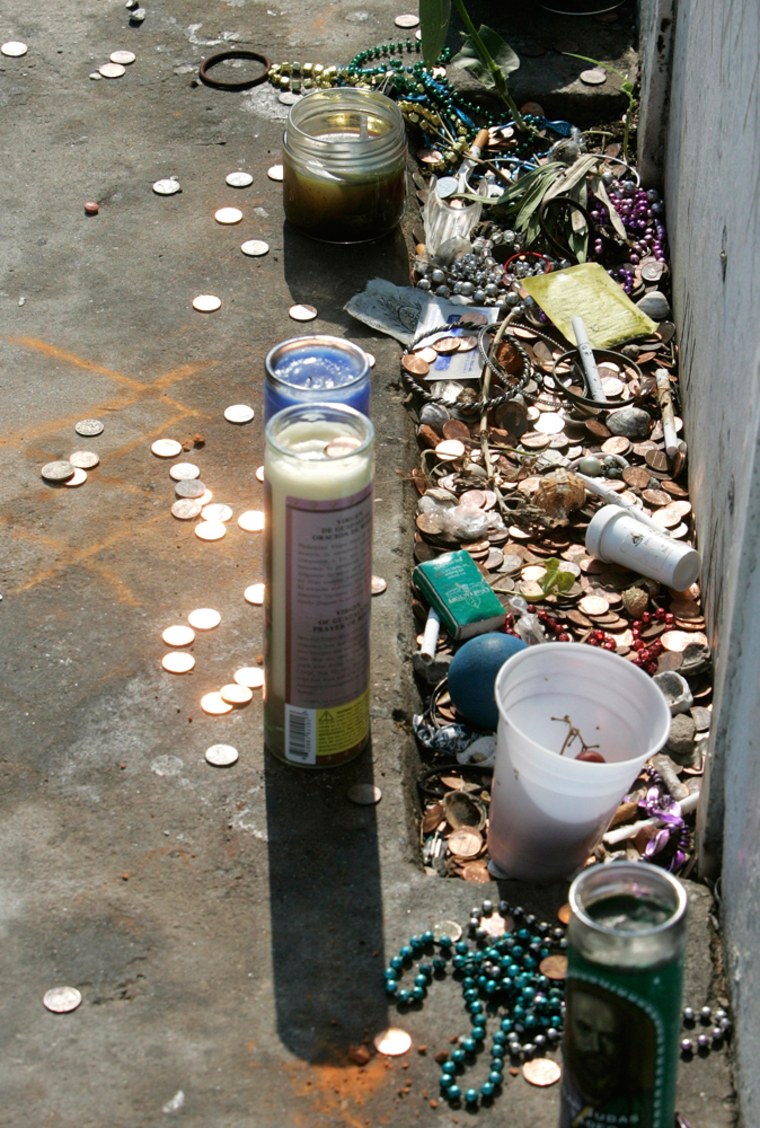On a recent morning, Jeffrey Scott stood before Marie Laveau's tomb in St. Louis Cemetery No. 1, shaking a cigarette out of a pack to leave as an offering for the famous voodoo queen.
Scott was placing the offerings with others — including Mardi Gras beads, flowers, candles and change — in front of the white Greek Revival tomb, covered with red Xs that some believe will move Laveau's spirit's to grant a wish.
"This is better than Bourbon Street," said Scott, 22, who had come from London with friends to New Orleans. "My friends at home will freak when they hear I saw this. They were saying how could I visit a cemetery, but wait until they see my pictures."
Death has a distinctive presence in New Orleans — people play music and dance at funerals; for burials they move old bones to make room for new; and tombs ranging from plain to ornate, from new to old, are the final resting places for many residents.
Now, after years of neglect, vandalism and theft, there are signs of life in New Orleans' "Cities of the Dead."
Love of unique cemeteries and concern for their decay has led to groups like Friends of New Orleans Cemeteries and Save Our Cemeteries, which have spearheaded fundraising efforts, renovations and cleanup campaigns that have sparked restoration in many of the cemeteries.
"Our cemeteries are unique," said Robert Florence, founder of Friends of New Orleans Cemeteries and the operator of Historic New Orleans Tours, which leads groups through the cemeteries. "Their history is remarkable, the architecture is remarkable, their beauty is remarkable."
The tomb reported to be Laveau's is among those that have been restored. The once chipped facade and crumbling roof are now smooth and brightly painted. The practice of marking it with Xs is condemned by preservationists, especially when it's done with pieces of brick broken from nearby unrestored tombs.
The New Orleans tradition of above ground burial, necessitated by the city's low elevation that caused graves to flood, has resulted in several kinds of tombs — the family tomb, the wall tomb, or "oven" because of their resemblance to ovens once used here, and the society tombs, where people could band together to secure a burial spot.
But as rich in history and architectural interest as they are, for years the 42 cemeteries in New Orleans were largely allowed to crumble.
"Families die off or move away, and if there isn't a perpetual care policy, the tomb begins to crumble," Florence said. "Without care over the years, you can just end up with a pile of rubble."
The oldest of the tombs were built of bricks then covered with a thin layer of plaster; the panels that listed those in the tomb were usually marble, which broke easily and from which the engraving faded over the years.
"The older tombs, in many cases, were little more than collapsed piles of brick," said Rachel Witwer, director of Save Our Cemeteries, which was founded in 1974 to help restore and preserve Louisiana's historical cemeteries.

Conditions in many cemeteries have improved since the low point in the 1980s when the Archdiocese of New Orleans considered selling neglected tombs.
It's not unheard of for tombs to be sold in New Orleans. Even some famous tombs have changed hands, with the remains of the bodies originally buried there removed and placed elsewhere with the permission of the relatives of the dead. Under the law, however, the Archdiocese was unable to carry out its plan, since it does not have legal control of those entombed there.
"Under the statute after 50 years of no activity, we have the right to place a tomb under public notice for a year, then we can restore it and sell it," said Jody Rome, director of the Archdiocese's cemeteries. "But they made no provision for what to do with the remains from the tombs."
Tombs in New Orleans allow for unlimited burials. After one year, the tomb may be opened, the bones removed from the coffin and placed in a receiving well in the tomb, which allows for a new burial.
Since 1984 all new tombs built in a Catholic cemetery in New Orleans have required perpetual care, which costs $2,700 — a one-time fee.
Though there is still work to be done, restoration efforts are beginning to pay off.
In St. Louis No. 1, which opened in 1789, many of the old tombs now gleam blindingly white in the sunlight.
And tourists have returned to cemeteries that were once considered dangerous enough to carry a police warning about visiting. In the past, tourists wandering along the twisting lanes between tombs at the oldest cemeteries were perfect targets for robbers.
"We have not had any reports of robberies in the cemeteries in recent years," said New Orleans Police spokesman Bob Young.
